Overview
Data federation represents a pivotal method that empowers organizations to retrieve and query information from diverse sources without necessitating physical consolidation. This innovation facilitates real-time access while preserving data at its original location. By adopting this approach, organizations can significantly enhance operational efficiency, reduce redundancy, and bolster compliance. This is particularly critical in sectors such as banking and healthcare, where effective information management is not just beneficial but essential. As a result, organizations must consider the transformative potential of data federation in navigating their information management challenges.
Introduction
In an increasingly data-driven world, organizations confront the formidable challenge of integrating vast amounts of information from disparate sources while ensuring both efficiency and security. Data federation stands out as a powerful solution, facilitating seamless access and real-time querying of data without necessitating physical consolidation. This innovative approach not only minimizes data redundancy but also significantly enhances decision-making processes across diverse sectors, from banking to healthcare.
As industries generate unprecedented volumes of data, understanding the mechanisms, benefits, and challenges of data federation becomes essential for businesses striving to harness valuable insights and sustain a competitive edge.
With advancements in technology and an escalating emphasis on compliance and security, the future of data federation is poised to transform how organizations manage and leverage their data assets. Are you ready to embrace this shift?
Understanding Data Federation: Definition and Key Concepts
Information unification represents an advanced method that empowers organizations to grasp the concept of data federation, enabling them to retrieve and query information from various distinct sources without necessitating physical consolidation. This innovative approach creates a cohesive perspective of information, illustrating data federation by allowing users to interact with multiple information sources as if they were part of a singular database. Unlike conventional methods of information combination, which often involve duplication and relocation, data federation signifies information unification that preserves content at its original source, facilitating real-time access and alleviating the challenges associated with information management.
This strategy proves especially advantageous in sectors where information is dispersed across multiple systems, such as banking and healthcare. It exemplifies data federation by offering secure and efficient access to vital information. Avato’s dedicated hybrid integration platform demonstrates how organizations can streamline disparate systems and enhance business value through effective information unification, simultaneously unlocking isolated assets. For instance, the healthcare sector generates approximately 30% of the global information volume, with projections indicating a compound annual growth rate of 36% by 2025.
This rapid growth underscores the critical importance of information integration in leveraging valuable insights from vast amounts of data. A case study titled “A Healthy Outlook for Information” illustrates how the healthcare sector’s information generation positions it at the forefront of information utilization, highlighting the necessity for robust information management strategies.
Recent statistics reveal that a significant percentage of organizations are adopting information unification for effective information management, raising the question of data federation. Forecasts suggest that by 2025, nearly 70% of companies in the banking industry will implement this method to enhance their information management strategies. Avato’s hybrid integration platform, supported by a team of integration specialists, enables businesses to future-proof their operations through seamless information and system integration, maximizing financial efficiency by circumventing costly transfers. Industry leaders emphasize the importance of information consolidation for secure access, noting that centralized trust models can consolidate power and deter collaboration among competitors.
As Devin Singh, Founder and CEO of Hero AI, asserts, the lack of clear guidelines in information management can expose organizations to liability, making robust information integration frameworks essential.
Real-world examples vividly illustrate data federation in healthcare and its effectiveness. To comprehend data federation, it is crucial to recognize that hospitals and healthcare providers are increasingly adopting federated information systems to improve patient care and operational efficiency while ensuring compliance with stringent regulatory requirements. Current trends indicate that as organizations navigate the complexities of information integration, the adoption of federated solutions, such as those offered by Avato, will be pivotal in shaping the future of management across diverse sectors.
The name ‘Avato,’ derived from the Hungarian word for ‘dedication,’ reflects the company’s commitment to architecting the technological foundation necessary to enable rich, connected customer experiences.
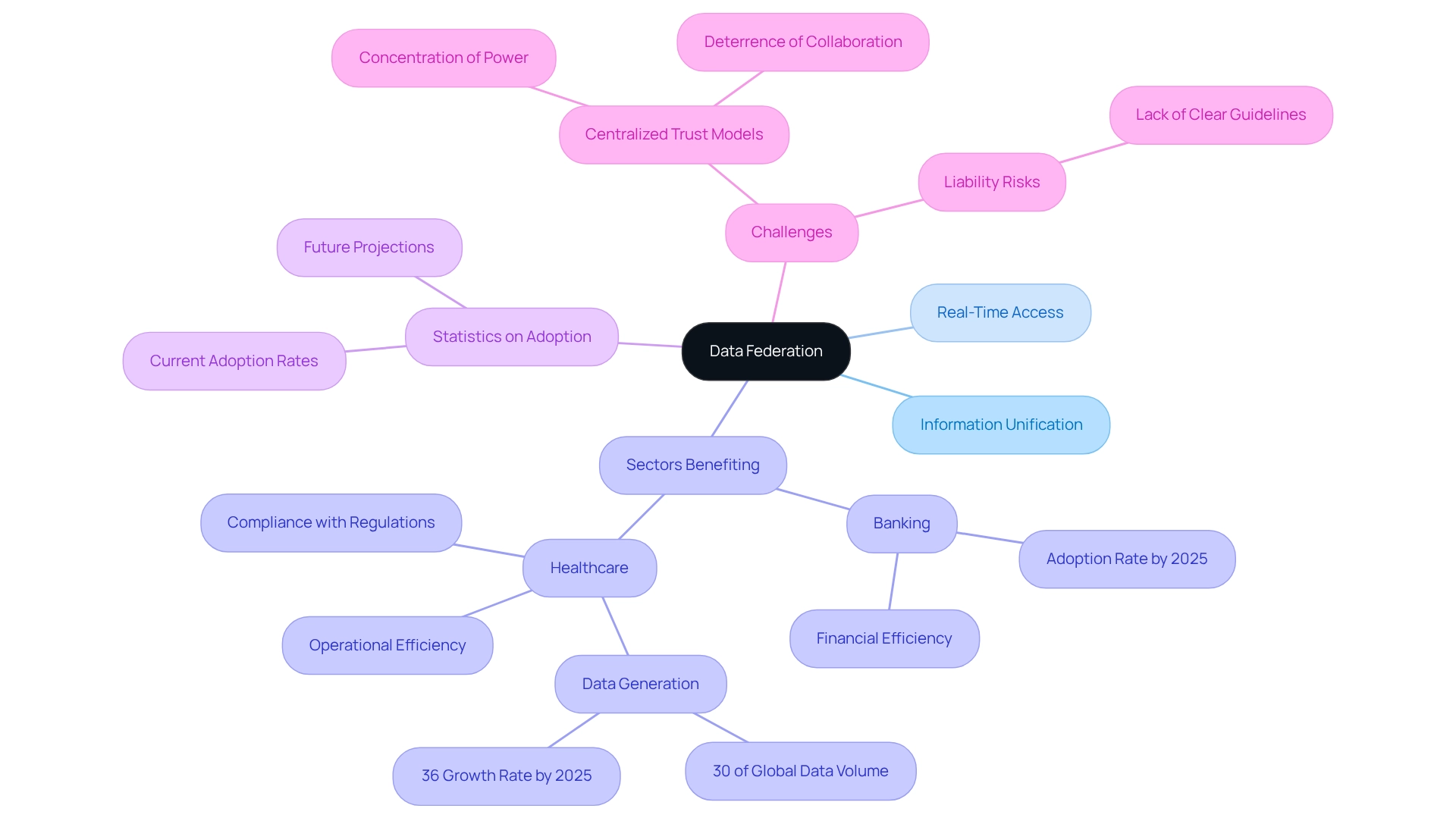
How Data Federation Works: Mechanisms and Processes
What is data federation? It operates through an advanced virtual layer that seamlessly connects various information sources, enabling users to perform queries across these sources without the need to physically transfer the information. This process, which illustrates what data federation entails, is facilitated by federated queries and managed by a middleware layer that translates user requests into the specific formats required by each information source. The results from these queries are then aggregated and presented to the user as a cohesive dataset, significantly streamlining information access.
This architecture not only enhances the retrieval of information but also boosts overall performance by minimizing unnecessary data movement. Middleware technologies, such as ODBC (Open Database Connectivity) and JDBC (Java Database Connectivity), play a critical role in establishing these connections, ensuring that information can be accessed effortlessly across diverse platforms and formats.
Recent advancements in 2025 highlight progress in federated queries technology, shedding light on what data federation represents as organizations increasingly adopt middleware solutions for information integration. Statistics indicate that middleware usage in IT environments has surged, with many organizations reporting an average time savings of up to 30% when utilizing data federation compared to traditional methods. This efficiency proves particularly beneficial in industries like banking, where timely access to information is essential.
Notably, this statistic is corroborated by the Wallenberg AI, Autonomous Systems and Software Program (WASP), funded by the Knut and Alice Wallenberg Foundation, lending credibility to claims regarding middleware efficiency.
Avato’s Hybrid Integration Platform enhances this process by maximizing and extending the value of legacy systems, simplifying complex integrations, and significantly reducing costs. Its architecture is designed for secure transactions and includes real-time monitoring and alerts, making it a trusted solution for banks, healthcare, and government sectors that require 24/7 uptime with no margin for defects, errors, or outages. Expert insights suggest that efficient information integration mechanisms not only enhance operational effectiveness but also improve security and compliance, which are vital in regulated sectors.
Piyush Ranjan notes that the transformative capability of AI in enhancing financial systems is substantial, underscoring the importance of AI in refining information integration, particularly within the banking industry. Case studies in banking systems, including the study titled ‘Impact of Pricing Policies on Service Rejections,’ illustrate what data federation is by showcasing the successful implementation of federated queries, demonstrating how institutions have leveraged these technologies to enhance their information management strategies and improve service delivery.
As the landscape of information unification continues to evolve, ongoing research aims to develop innovative methods for ontology-based diverse content unification, further enhancing the functionalities of information-sharing systems and their impact on the banking industry. Additionally, banks should consider integration strategies for open banking to ensure they are well-prepared for the changing financial landscape.
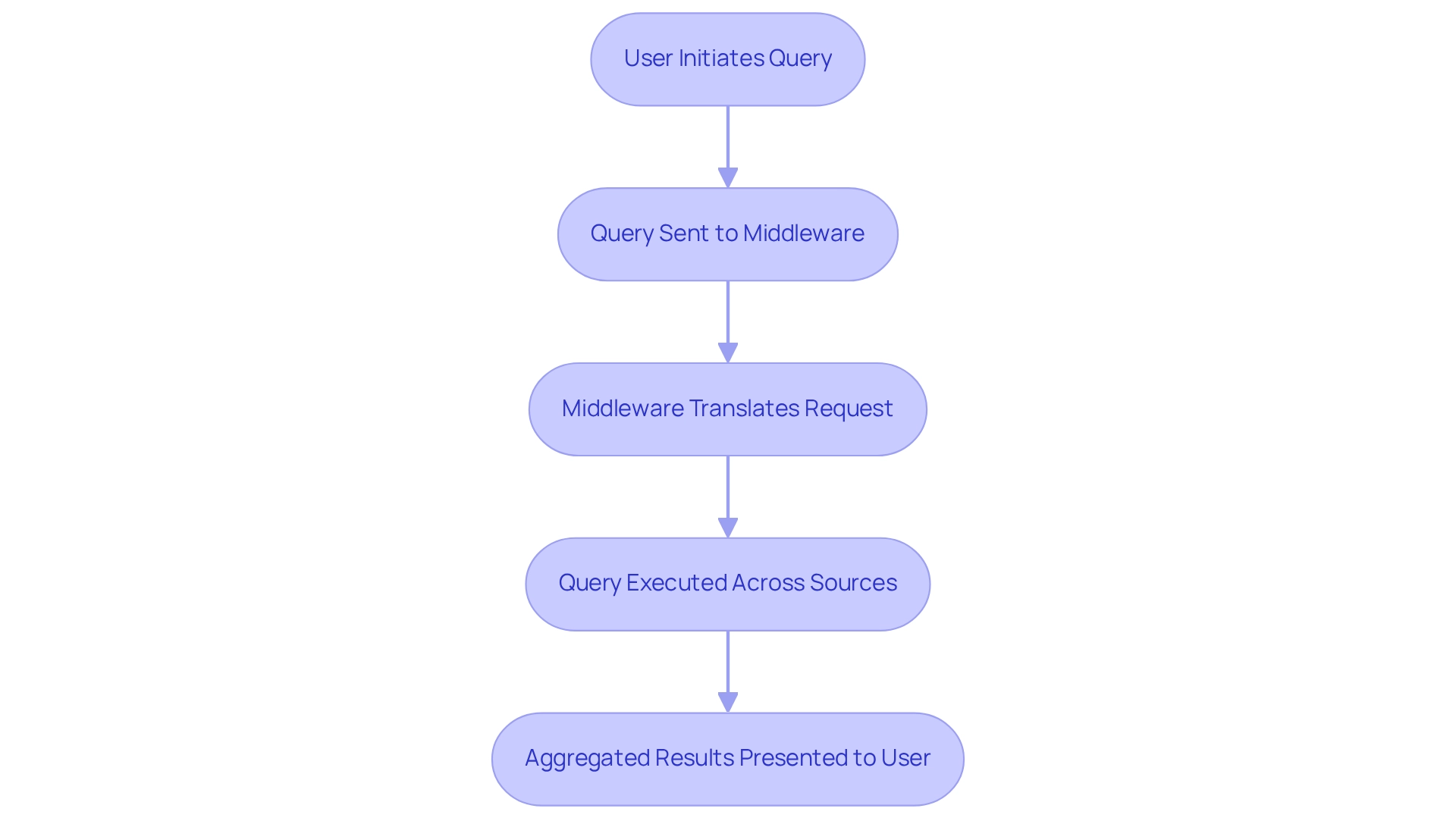
Benefits of Data Federation: Enhancing Data Access and Integration
Information aggregation presents numerous benefits that significantly enhance operational efficiency, improve information accessibility, and reduce redundancy. By facilitating real-time access to information from diverse sources, organizations can expedite their decision-making processes, leading to more informed, evidence-based outcomes. This capability is particularly critical in sectors like banking, where timely access to accurate information can influence strategic decisions.
A key advantage of information integration lies in its ability to eliminate the need for information duplication. This not only cuts down on storage costs but also mitigates the risks associated with information inconsistency, which can arise when multiple copies of the same data exist. As a result, organizations can maintain a single source of truth, bolstering information governance and ensuring that users have the necessary access without compromising data integrity.
Moreover, information aggregation supports compliance with regulatory requirements by allowing sensitive data to remain within its original source while still being accessible for analysis. This aspect is especially pertinent in heavily regulated industries such as banking and healthcare, where data security and privacy are paramount. However, challenges such as maintaining data consistency, optimizing queries, ensuring security, and managing implementation must be addressed to fully capitalize on the benefits of information integration.
Expert insights emphasize the significance of information integration in minimizing redundancy. By streamlining information access and management, organizations can enhance operational efficiency and foster a culture of evidence-based decision-making. For instance, Avato’s hybrid merging platform exemplifies this by reducing storage costs, protecting information through encryption, and enabling rapid dataset generation, ensuring 24/7 availability for critical connections.
Practical examples further illustrate the transformative impact of information unification. A striking case is Personio’s automation of assessments, where the integration of federated information solutions dramatically reduced the time candidates spent on evaluations, thereby simplifying the hiring process. This aligns with Avato’s capabilities, which are tailored for secure transactions and trusted by banks, healthcare, and government sectors, empowering organizations to implement similar solutions effectively.
As Gustavo Estrada remarked, Avato simplifies intricate projects and delivers results within specified time frames and budget constraints, underscoring the value of unified solutions in achieving operational efficiency.
In conclusion, the benefits of information pooling extend beyond mere cost savings; they include enhanced accessibility, improved compliance, and a solid framework for effective governance. As organizations continue to navigate the complexities of data management, understanding data federation will be essential for the strategic implementation needed to maintain a competitive advantage in 2025 and beyond. Furthermore, Avato supports 12 levels of interface maturity, enabling organizations to balance the speed of integration with the complexity required to future-proof their technology stack.
For further insights, please refer to our FAQs on integration strategies and stakeholder engagement.
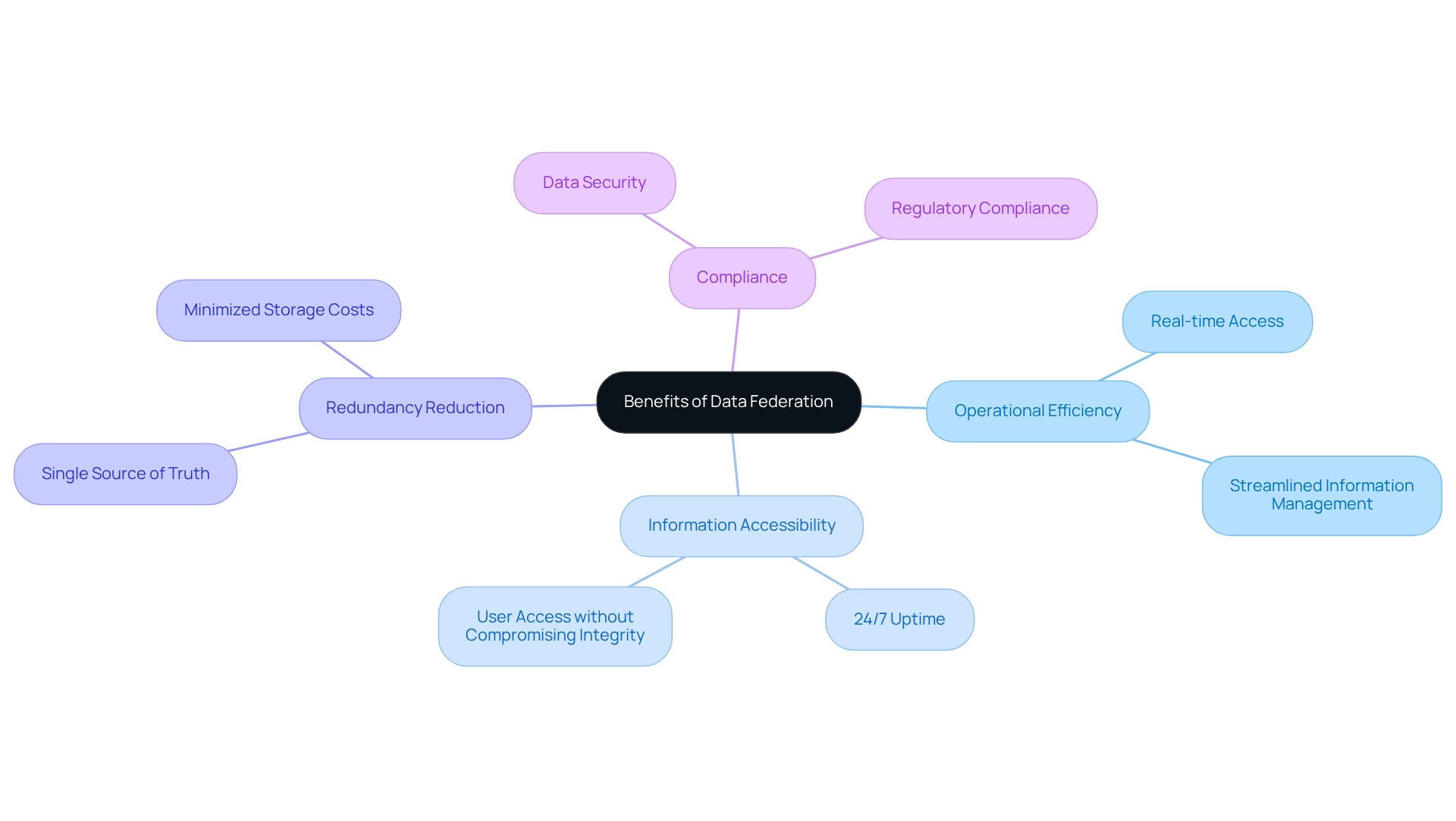
Challenges of Data Federation: Navigating Potential Pitfalls
While providing various benefits, data integration and the concept of data federation present a series of challenges that organizations must navigate. A primary concern is the potential for performance bottlenecks, particularly when querying extensive datasets across multiple sources. Research indicates that nearly 70% of organizations encounter substantial delays in information retrieval due to ineffective federation processes, underscoring the significance of grasping the concept of data federation. Such delays can hinder timely decision-making and operational efficiency.
Ensuring information consistency is another complex challenge, as real-time updates across various locations can lead to discrepancies. In fact, studies indicate that 60% of enterprises report difficulties in maintaining information integrity within federated systems, emphasizing the critical need to understand data federation and how it can compromise the reliability of insights derived from such information.
Security remains a paramount concern, especially when sensitive information is involved. Organizations must implement robust security measures to safeguard information across diverse platforms, as breaches can have severe repercussions. Furthermore, the incorporation of various information sources often complicates governance, necessitating clear policies and standards to manage access and compliance effectively.
Real-world examples vividly illustrate these challenges. For instance, a healthcare organization experienced considerable delays in patient information retrieval due to performance bottlenecks in their federated system, adversely affecting their capacity to deliver timely care. Similarly, a financial institution grappled with data consistency issues that led to erroneous reporting, raising the question of what data federation entails and highlighting the need for stringent governance frameworks.
Avato, established in 2010, has successfully executed hybrid unification solutions across diverse financial institutions, effectively addressing these challenges. Its hybrid unification platform guarantees 24/7 availability for critical connections, essential for maintaining operational reliability in regulated environments like banking and healthcare. This platform not only streamlines intricate connection projects but also enhances business value by facilitating effortless and secure information connectivity.
A notable example is Avato’s collaboration with Coast Capital, where the solution went live in February 2013, enabling major system transitions with minimal downtime. As Gustavo Estrada noted, “Aviator has the ability to simplify complex projects and deliver results within desired time frames and budget constraints,” underscoring the platform’s effectiveness in overcoming integration hurdles.
IT professionals, particularly Banking IT Managers, must be acutely aware of these challenges and proactively develop strategies to address them. This involves investing in advanced monitoring solutions to enhance performance and ensure reliability, alongside establishing comprehensive governance policies to uphold information integrity and security. By doing so, companies can improve their information integration efforts and harness the full capability of their combined systems, supported by Avato’s dependable, future-ready technology framework that assists enterprises in adapting to evolving requirements.

Implementing Data Federation: Best Practices for Success
To effectively execute information unification, organizations must adhere to several best practices that enhance both performance and compliance. First, conducting a thorough evaluation of current information sources is essential. Understanding the connections among these sources enables the creation of a robust federation framework tailored to organizational requirements.
This evaluation should align with the institution’s objectives and the evolving needs of clients, as emphasized in Avato’s strategic planning method.
Establishing clear information governance policies is equally crucial. These policies not only ensure information quality but also foster adherence to regulatory requirements, particularly in sectors such as banking and healthcare. As noted by the National Academies of Sciences, Engineering, and Medicine, this vision will demand additional resources, at least in the short term, underscoring the necessity for funding in information integration initiatives.
Organizations should invest in advanced middleware solutions capable of efficiently managing combined queries, thereby enhancing information retrieval processes. For instance, Avato guarantees round-the-clock uptime for essential connections, reinforcing the reliability of information-sharing solutions.
Ongoing monitoring and enhancement of the sharing framework are vital to maintain high performance and swiftly address any emerging challenges. This proactive approach mitigates risks associated with information integration and bolsters overall system reliability, aligning with Avato’s commitment to maximizing integration performance through continuous analytics. Moreover, fostering collaboration between IT and business units is essential.
Engaging stakeholders early in the execution process ensures that the information integration strategy aligns with organizational objectives, ultimately leading to more efficient access and utilization of resources. The significance of involving relevant stakeholders during implementation cannot be overstated, as it can avert solutions that fail to meet organizational needs.
Additionally, Product Owners play a critical role in bridging business goals and technical implementation, managing product backlogs and prioritizing needs. Their expertise ensures alignment with business objectives and efficient product development, which is crucial for successful information integration initiatives.
By adhering to these optimal strategies, organizations can significantly enhance their information integration efforts, facilitating successful digital transformation with Avato’s Hybrid Integration Platform. Download our comprehensive guide on structured requirements management to elevate your information integration initiatives.
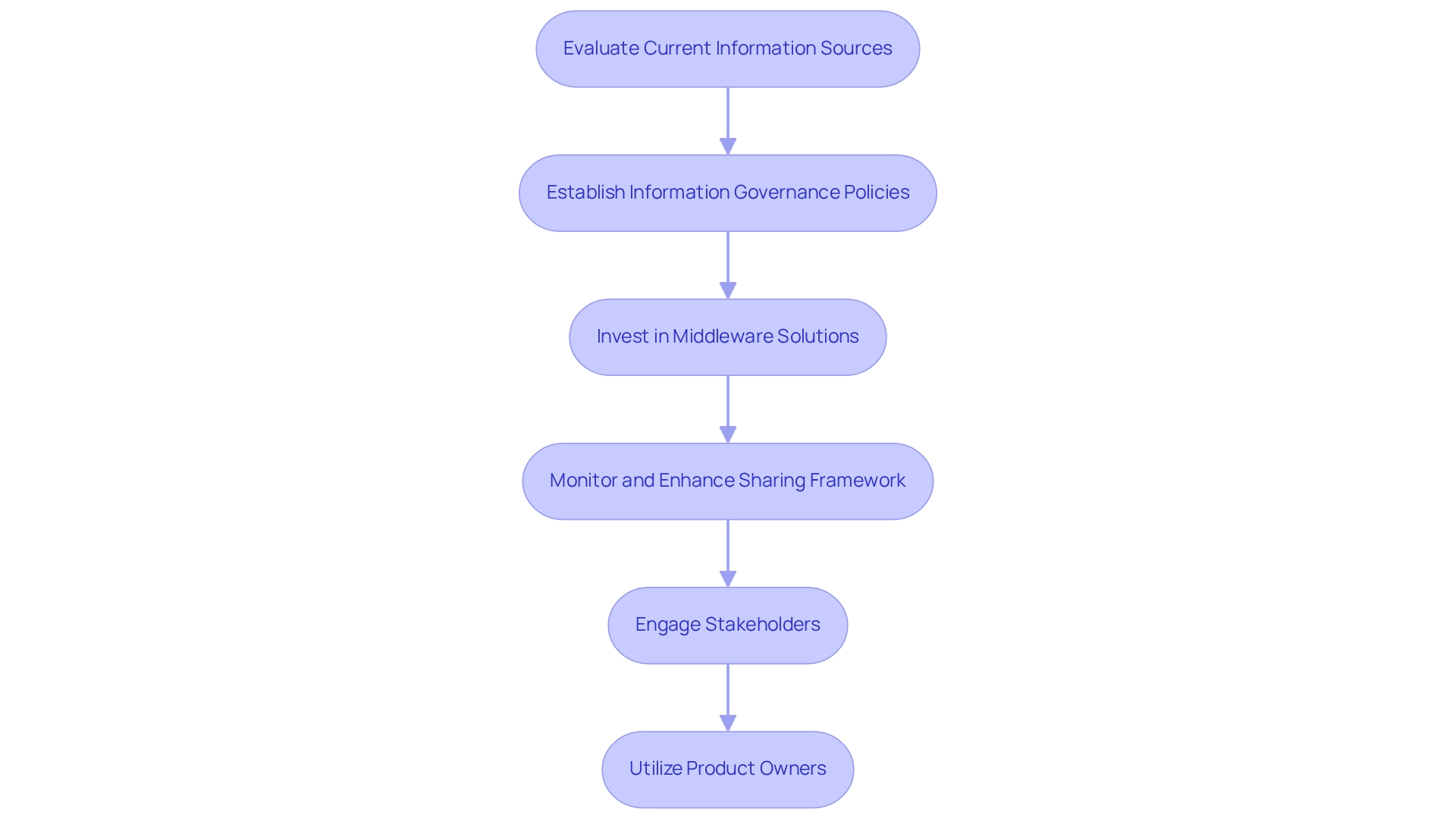
The Future of Data Federation: Trends and Innovations
The future of information integration is on the brink of transformative changes, largely propelled by advancements in artificial intelligence and machine learning. These technologies are set to significantly enhance the capabilities of information unification systems, paving the way for more sophisticated integration and analysis methods. As organizations increasingly adopt multi-cloud strategies, the role of information unification will become critical in ensuring seamless access to resources across diverse environments.
Moreover, the adoption of cloud computing is on the rise, with evidence indicating that businesses are turning to hybrid architectures to achieve greater flexibility and scalability in their federation implementations. This evolution not only improves information accessibility but also aligns with the growing demand for strategic information leverage. The projected 25% annual growth in analytics skills necessary to navigate this shifting landscape underscores the vital importance of information science in digital transformation efforts across various industries.
In this landscape, Avato’s hybrid integration platform emerges as a game-changing solution for financial institutions, facilitating cost reduction, accelerated product delivery, and enhanced customer satisfaction. Avato has proven its effectiveness through successful deployments, such as its collaboration with Coast Capital, where the solution went live in February 2013. This initiative enabled major system transitions with minimal downtime, including a remarkable switch of the entire telephone banking and contact center telephony system with just a 63-second outage in June 2016. Such expertise positions Avato as an indispensable partner for organizations aiming to refine their information federation strategies by clarifying what data federation truly entails.
Additionally, Avato collaborates with managed service providers worldwide, delivering a comprehensive suite of services, including:
- enterprise architecture
- solutions architecture
- infrastructure architecture
- business analysis
- technical analysis
- project management
- interface design and development
- software development
- quality assurance
Establishing robust information governance frameworks will empower organizations to manage their federated information environments more effectively. This capability is crucial for ensuring compliance and security while maximizing the value derived from their information assets.
As Timothy Owens, a senior research lead in technology and telecoms, aptly states, “Navigating this new era requires embracing increasingly powerful AI tools to gain a competitive edge, while simultaneously addressing ethical concerns and ensuring responsible development.” This perspective highlights the necessity of integrating AI advancements into information integration strategies, setting the stage for a future where information is not only accessible but also actionable and secure. Furthermore, federal agencies will encounter procurement challenges in 2025 as they expedite the adoption of artificial intelligence technologies, emphasizing the urgency of comprehending what data federation means within their strategies.
Avato’s reliable technology stack and expert integration services will be essential in assisting businesses to adapt to these evolving demands.
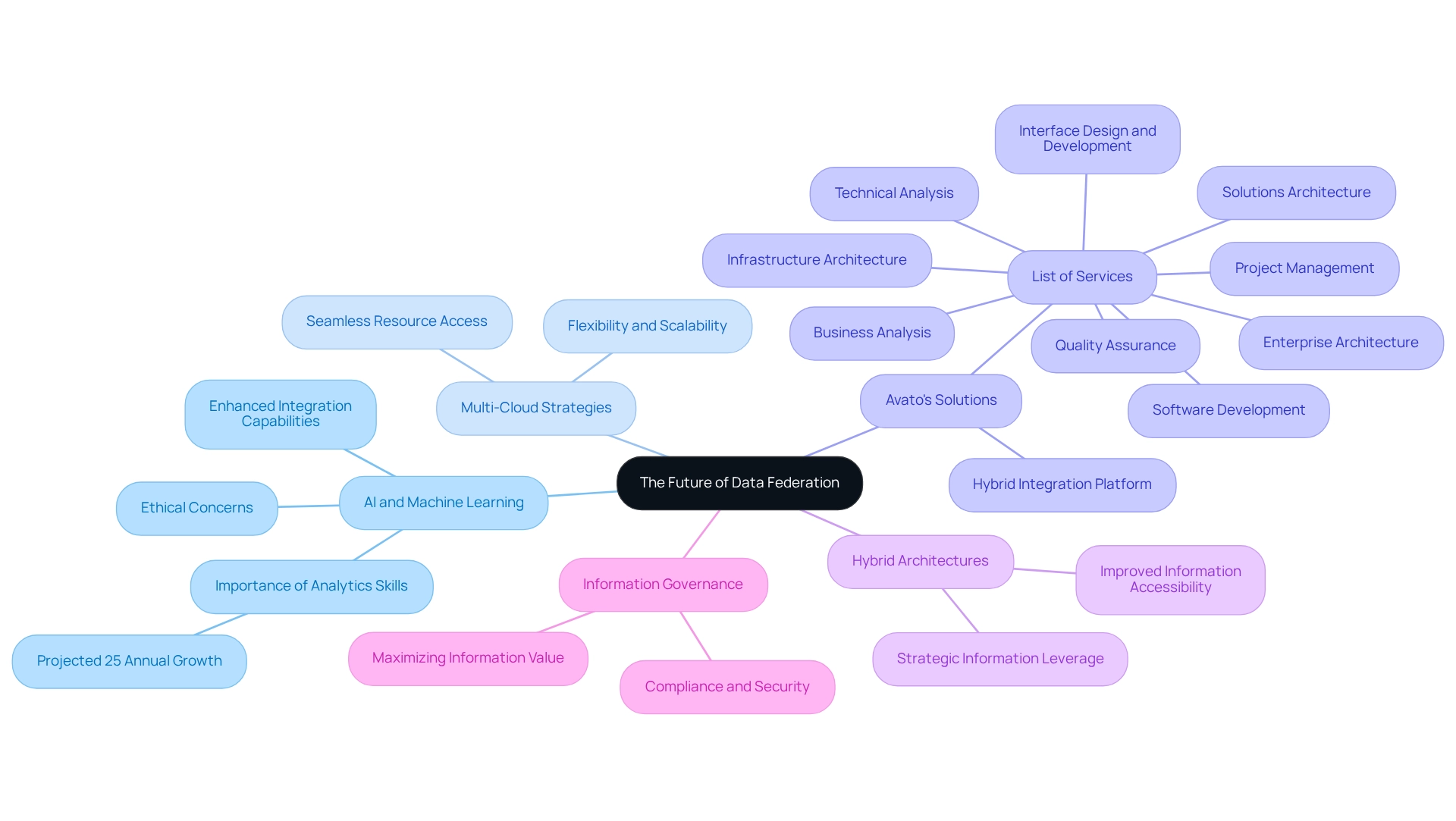
Conclusion
Data federation stands out as a transformative solution in today’s data-driven landscape, empowering organizations to seamlessly access and integrate vast amounts of information. By facilitating real-time access to disparate data sources without necessitating physical consolidation, data federation minimizes redundancy, enhances efficiency, and bolsters informed decision-making across sectors such as banking and healthcare. The implementation of advanced middleware solutions, like those provided by Avato, further enables organizations to optimize their data management strategies and ensure compliance with regulatory requirements.
Yet, the journey toward effective data federation is fraught with challenges. Organizations must confront potential performance bottlenecks, data consistency issues, and security concerns. By adopting best practices such as robust data governance, continuous monitoring, and stakeholder engagement, businesses can navigate these obstacles and fully harness the benefits of data federation.
Looking to the future, the prospects for data federation are promising, propelled by innovations in artificial intelligence and the rising adoption of multi-cloud strategies. As organizations adapt to the evolving digital landscape, the significance of data federation will only increase. Embracing this shift is crucial for organizations seeking to maximize their data assets, enhance operational efficiency, and maintain a competitive edge in the market. The time to invest in data federation strategies is now; they represent a critical pathway to unlocking the true potential of organizational data.

